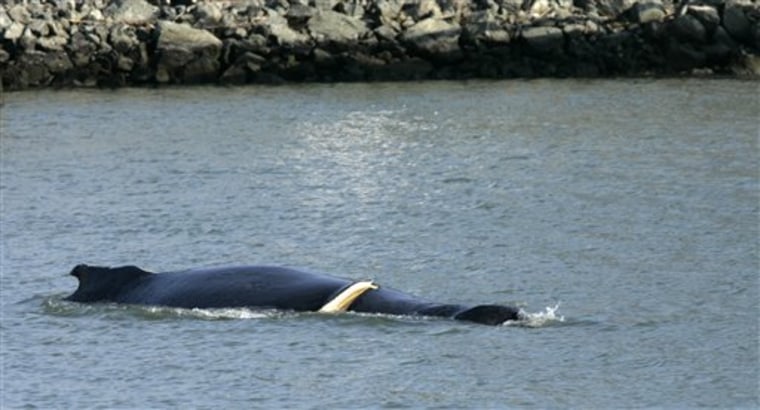The recorded siren songs of humpback whales played from a Coast Guard cutter Thursday as biologists tried to lure an injured whale and her calf out of a shipping channel and back toward the Pacific Ocean, 90 miles away.
It could take weeks to get the two whales back where they belong, scientists said. Still, hundreds of people lined the river banks to watch the progress Thursday morning.
The procedure worked 22 years ago with another humpback that wandered for nearly a month in the Sacramento-San Joaquin Delta before returning to the ocean, said Bernie Krause of Wild Sanctuary in Glen Ellen, Calif.
“Hopefully, these will do the same thing we did for Humphrey the whale when Humphrey was stuck,” Krause said before starting recordings, which he described as the sounds of humpback whales feeding. “It’s like the dinner bell.”
Plan B: Herd them
If the sounds aren’t enough, wildlife officials will try a different tactic — lining the channel with more boats to herd the whales in the right direction, said Frances Gulland, director of veterinary science at the Sausalito-based Marine Mammal Center.
Biologists hope to get the whales back into the Pacific Ocean, where food is more plentiful and the salty water can heal their wounds.
The cuts were apparently caused by a boat propeller. Scientists checked them Wednesday using photos of the animals swimming in the Port of Sacramento. If the whales can be returned to their natural sea water habitat, which is cleaner than the fresh water in the port, they likely won’t need treatment, the researchers said.
"The injury on the female is about 2 feet long, 6 inches deep, and has sharp edges typical of a propeller wound. We don't think it's life-threatening," Gulland said.
The calf's wound appeared to be deeper but was difficult to assess because it is on its underside, below the water line, Gulland said.
Biologists had feared the larger whale was entangled in some sort of fishing gear, but what appeared to be an object wrapped around it is actually blubber, Gulland said.
The two likely had been on their northward migration from Mexico up the California coast when they were sidetracked and spotted Sunday in the lower Sacramento River, biologists said. Because they are at the end of their hibernation season, they have less blubber to rely on for fuel than they would later in the summer or fall.
Murky water a problem
The pair spent Wednesday exploring the muddy waters of the Sacramento River basin as hundreds of people flocked to the banks to see them.
Shipping and small boat traffic were halted in the basin, which is 30 feet deep and 200 feet wide. The next ship was not expected to dock for another week, giving authorities time to try to escort the whales out of the channel and back to the Pacific, said Teresa Bledsoe, administrative clerk at the Port of Sacramento.
A flotilla of Coast Guard and law enforcement boats planned to follow the whales to make sure they didn’t head back up the channel.
One concern for the whales’ trip is the murky water and many estuaries of the delta, a vast network of rivers and canals that drains two-thirds of California’s land mass. Scientists fear they could lose track of the whales and said they were considering marking them with locator tags.
